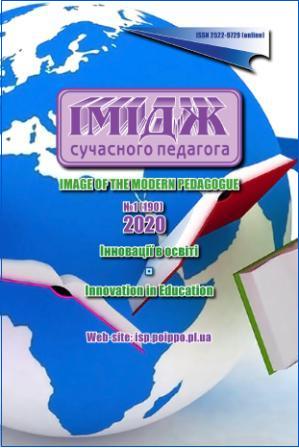Концепція розвитку медіаосвіти у законодавстві Канади
DOI:
https://doi.org/10.33272/2522-9729-2020-1(190)-54-60Ключові слова:
медіаосвіта, інформаційні технології, законодавче забезпечення, медіа освітні організації, регіональний та національний рівеньАнотація
Розкривається відображення концепції розвитку медіаосвіти у законодавстві Канади. Наголошується на значенні сучасних інформаційних технологій, комп’ютерної комунікації та мереж у створенні нових передумов для удосконалення освіти людини. Автором проаналізовано найбільш вагомі закони, законопроекти та інші нормативно-правові документи Канади, що регламентують медіаосвіту. Зосереджена увага на активній політиці провайдерів медіаосвіти з акцентом на недержавних, некомерційних та громадських організаціях щодо впровадження медіаосвіти та виховання медіаграмотності у населення як основи розв’язання низки соціальних проблем країни. Автор акцентує увагу на тому, що медіаосвітні організації в своїй діяльності дотримуються певного концептуального підходу. Виявлено нову тенденцію на ринку медіаосвіти – співпраця медіавиробників та медіапедагогів, що сприяє поширенню медіаосвіти в Канаді.
Посилання
Andersen N., Duncan B., Pungente, J. Media Education in Canada – the Second Spring. Children and Media: Image. Education. Participation / eds. C. Feilitzen, U. Carlsson. Geteborg: The UNESCO International Clearinghouse on Children and Violence on the Screen at Nordicom, 1999. Р. 139–162.
Balancing copyright law in the digital age: comparative perspectives / eds.: R. Caso, F. Giovanella. New York, NY : Springer, 2015. 145 p.
Bringing Schools into the 21st Century / eds.: W. Guofang, D. Gut. US, Athens : Springer, 2011. 250 p.
Canada Council for the Arts. Shaping a New Future. Strategic Plan 2016-2021. URL: http://canadacouncil.ca/-/media/Files/CCA/Commitments/StrategicPlan/StrategicPlan_2016.pdf[30.01.2018]. (Last accessed: 17.01.2018).
Canada: The New Age Of Cyberbullying / eds. D. Daniele, R. Norton. Canada : Fulbright LLP Mondaq, 2018. 93 p.
The Common Curriculum: Provincial Standards, Language, Grades 3, 6, and 9. Ontario : Ministry of Education, 1994. 182 p.
The Common Curriculum: Policies and Outcomes, Grades 1-9. Ontario : Ministry of Education, 1995. 112 p.
Merrin W. Media studies 2.0. Abingdon : Taylor & Francis, 2014. 205 p.
Pungente J., O’Malley M. More than meets the eye: watching television watching us. Toronto : McClelland & Stewart Inc., 1999. 283 p.
Strategies for media Reform. International Perspectives / eds.: D. Freedman, J. Obar, Ch. Martens, R. McChesney. US : Fordham University Press, 2016. 360 p.
Teacher quality in Canada / eds.: S. Phillips, M. Raham. Kelowna : Society for the advancement of excellence in education, 2002. 98 p.
Wilson C., Duncan, B. Implementing Mandates in Media Education: The Ontario Experience. URL: http://www.revista.comunicar.com/pdf/comunicar32-en.pdf, 127-140 (Last accessed: 05.07.2018)
References
Andersen, N., Duncan, B., & Pungente, J. (1999). Media Education in Canada – the Second Spring. In C. Feilitzen, & U. Carlsson (Eds.), Children and Media: Image. Education. Participation (pp. 139-162). Geteborg: The UNESCO International Clearinghouse on Children and Violence on the Screen at Nordicom.
Canada Council for the Arts. (2016). Shaping a New Future. Strategic Plan 2016-2021. Retrieved from http://canadacouncil.ca/-/media/Files/CCA/Commitments/StrategicPlan/StrategicPlan_2016.pdf[30.01.2018].
Caso, R., & Giovanella, F. (Eds). (2015). Balancing copyright law in the digital age: comparative perspectives. New York, NY: Springer.
Daniele, D., & Norton, R. (Eds.). (2018). Canada: The New Age Of Cyberbullying. Canada: Fulbright LLP Mondaq.
Freedman, D., Obar, J., Martens, Ch., & McChesney, R. (Eds.). (2016). Strategies for media Reform. International Perspectives. US: Fordham University Press.
Guofang, W., & Gut, D. (Eds.). (2011). Bringing Schools into the 21st Century. US, Athens: Springer.
Ministry of Education. (1994). The Common Curriculum: Provincial Standards, Language, Grades 3, 6, and 9. Toronto: OISE Press.
Ministry of Education. (1995). The Common Curriculum: Policies and Outcomes, Grades 1-9. Toronto: OISE Press.
Merrin, W. (2014). Media studies 2.0. Abingdon: Taylor & Francis.
Pungente, J. & O’Malley, M. (1999). More Than Meets the Eye: Watching Television Watching Us. Toronto: McClelland & Stewart Inc.
Phillips, S. & Raham, M. (Eds.). (2002). Teacher quality in Canada. Kelowna: Society for the advancement of excellence in education.
Wilson, C., & Duncan, B. (2008). Implementing Mandates in Media Education: The Ontario Experience. [PDF file]. Retrieved from http://www.revista.comunicar.com/pdf/comunicar32-en.pdf, 127-140.
##submission.downloads##
Опубліковано
Як цитувати
Номер
Розділ
Ліцензія
Авторське право (c) 2020 Імідж сучасного педагога

Ця робота ліцензується відповідно до Creative Commons Attribution-NonCommercial-ShareAlike 4.0 International License.
Автори, які публікуються у цьому журналі, погоджуються з наступними умовами:- Автори залишають за собою право на авторство своєї роботи та передають журналу право першої публікації цієї роботи на умовах ліцензії Creative Commons Attribution License, котра дозволяє іншим особам вільно розповсюджувати опубліковану роботу з обов'язковим посиланням на авторів оригінальної роботи та першу публікацію роботи у цьому журналі.
- Автори мають право укладати самостійні додаткові угоди щодо неексклюзивного розповсюдження роботи у тому вигляді, в якому вона була опублікована цим журналом (наприклад, розміщувати роботу в електронному сховищі установи або публікувати у складі монографії), за умови збереження посилання на першу публікацію роботи у цьому журналі.
- Політика журналу дозволяє і заохочує розміщення авторами в мережі Інтернет (наприклад, у сховищах установ або на особистих веб-сайтах) рукопису роботи, як до подання цього рукопису до редакції, так і під час його редакційного опрацювання, оскільки це сприяє виникненню продуктивної наукової дискусії та позитивно позначається на оперативності та динаміці цитування опублікованої роботи (див. The Effect of Open Access).



